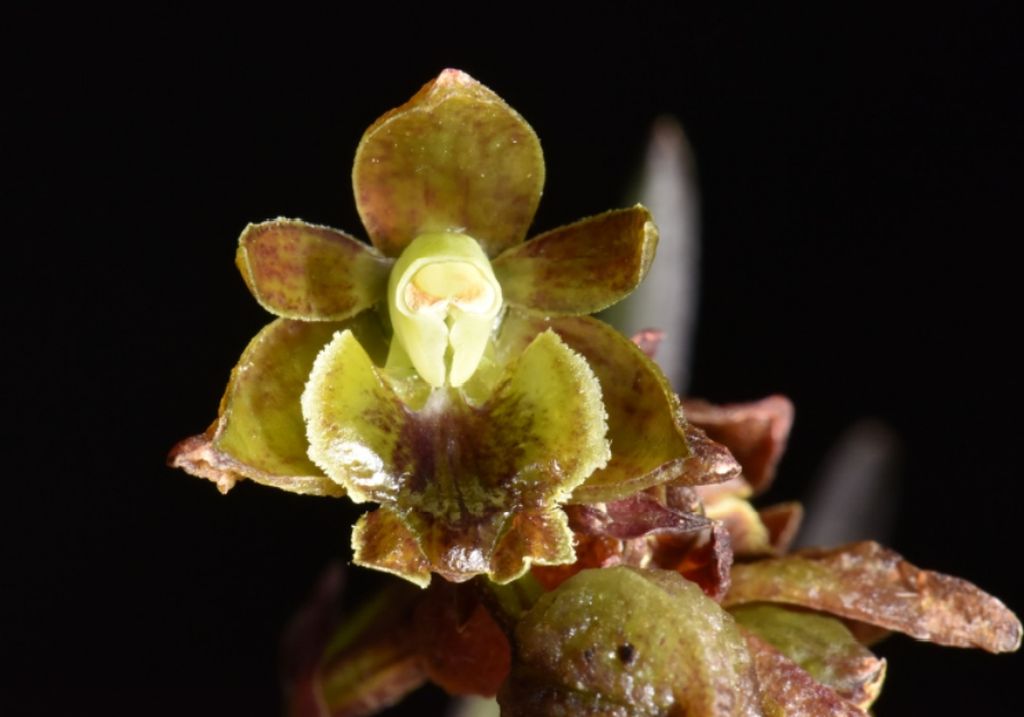

Epidendrum litteraense Hágsater, E.Santiago & Uribe Vélez 2018 GROUP Diothonea
TYPE Photo/TYPE Drawing by © R Jimenez and The AMO Herbaria Website
Common Name The Paramo de Letras Epidendrum [location of the orchid]
Flower Size .8" [2 cm]
Found in Caldas department of Colombia on the western slope of the Cordillera Central, in the basin of the Chinchiná River, at elevations around 2900 meters as a small sized, cold growing epiphyte with branching near the apex when mature, new branches produced in
succession from the sub-apical internodes of the previous stems, cane-like, terete, thin stems carrying
3 to 4 on the branches, those of the primary stem not seen, aggregated towards the apex of each stem, sub-erect, alternate, articulate, somewhat
canaliculate especially towards the conduplicate base, dark green with the margin reddish, shiny above, glaucous on the underside; provided basally with a
tubular, striated, reddish brown sheath; blade oblong-lanceolate, sub-acute, minutely apiculate, margin entire leaves that blooms in the summer on a terminal, without a spathe, peduncle .4" [10 mm] long, terete, provided with a bract .28" [7 mm] long; rachis .52 to 1.12" [13 to
28 mm] long, terete, .92 to 1.52" [2.3 to 3.8 cm] long, apical, racemose, arching-nutant, simultaneouly 10 flowered inflorescence with half as long as the ovary, narrowly triangular, acuminate floral bracts and carrying resupinate, fragrance not noted, when
mature reddish brown flowers with the column yellow, floral buds green, scarcely tinged with reddish brown; segments vernicose on the inside, matte outside.
"Epidendrum litteraënse belongs to the GROUP Diothonea, characterized by the branching habit, linear-lanceolate to
lanceolate, bilobed leaves, arching-nutant, racemose inflorescence, membranaceous or rarely fleshy flowers, the lip entire to 3-lobed, with an erose margin,
ecallose, without or with 1 to 10 thin, glabrous to erose keels, the column united to the lip from totally to obliquely to free. The species is recognized by the
reddish brown flowers with the lip obliquely united to the basal half of the column which is oblique, triangular, dorsally long and arching, the underside
short, the apex long with narrow involute, lateral wings; lateral sepals .46" [11.5 mm] long, dorsally pustulate, with a prominent, erose dorsal keel; ovary
triquetrous, the apex of the column forming a very narrow vertical aperture. Epidendrum pustulosum Hágsater, M.Rincón & García-Revelo is very similar but
the flowers are yellow, concolor, and the apex of the column has a very wide aperture. Epidendrum tropinectarium Hágsater & E.Santiago has pink flowers,
the column pale green, lip united to the column throughout its length, column thin and arched upwards, petals linear, with apex acute. It is very similar to
Epidendrum aureoglobiflorum Hágsater & Dodson from southern Ecuador, but that species has a straight column, entire lip and sepals .42 to .376" [8.3 to 9.4 mm] long,
dorsally verrucose, and a terete ovary. Epidendrum dolichorhachis Hágsater & Dodson has similarly colored flowers, but the inflorescence is 2.4 to 5" [6 to 12.5 cm] long,
with up to 30 flowers, the lip united to the column throughout its length, the column thick, arched upwards, lip with 5 erose-serrate ribs, and the ovary
terete." Hagsater etal 2018
Synonyms
References W3 Tropicos, Kew Monocot list , IPNI ;
*
Icones Orchidacearum 16[1] Plate 1636 Hagsater 2018 drawing fide;
Icones Orchidacearum 16[1] Plate 1651 Hagsater 2018 see recognition section;
--------------------------------------------------------------------------------------------------------------------------

